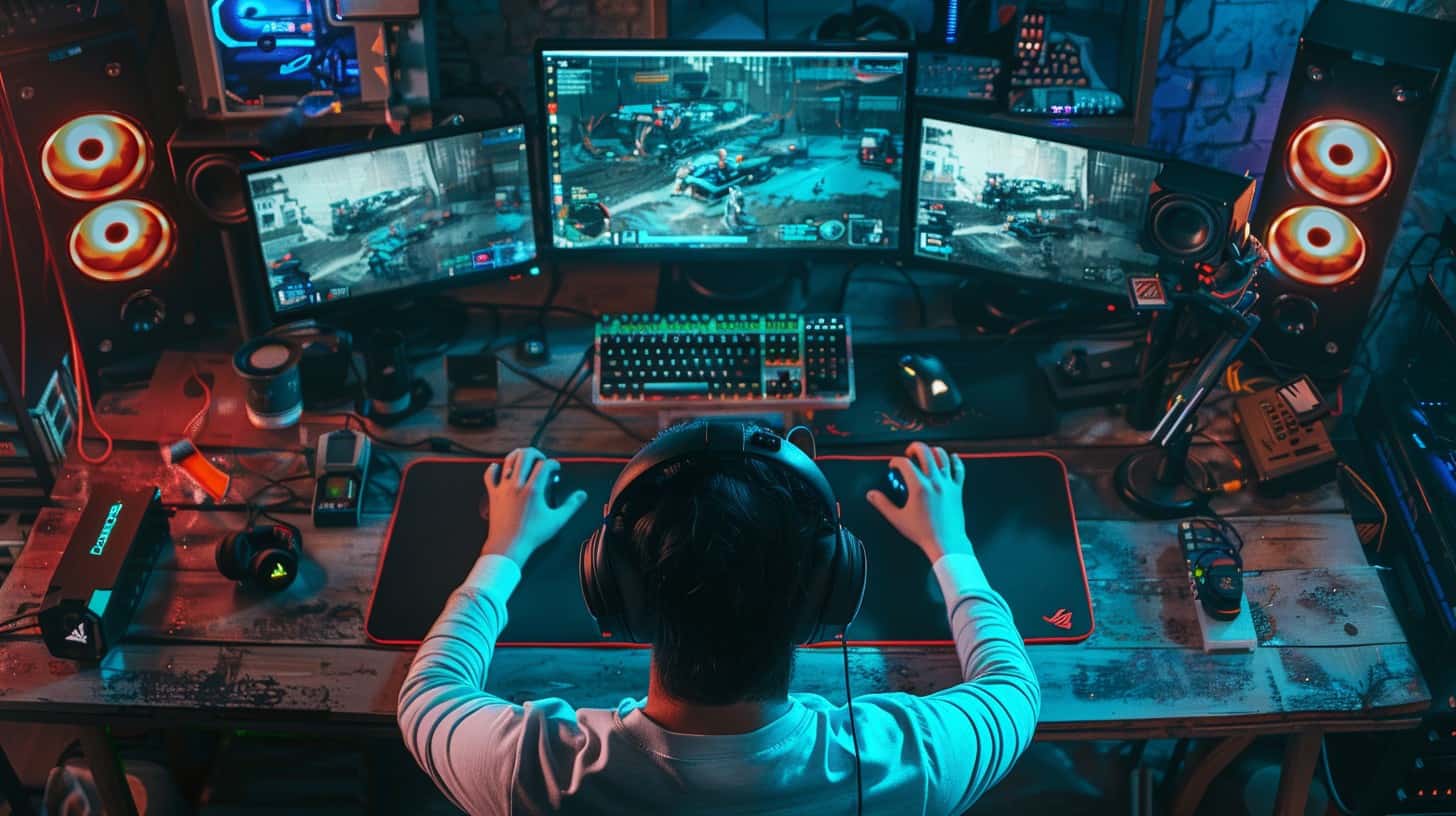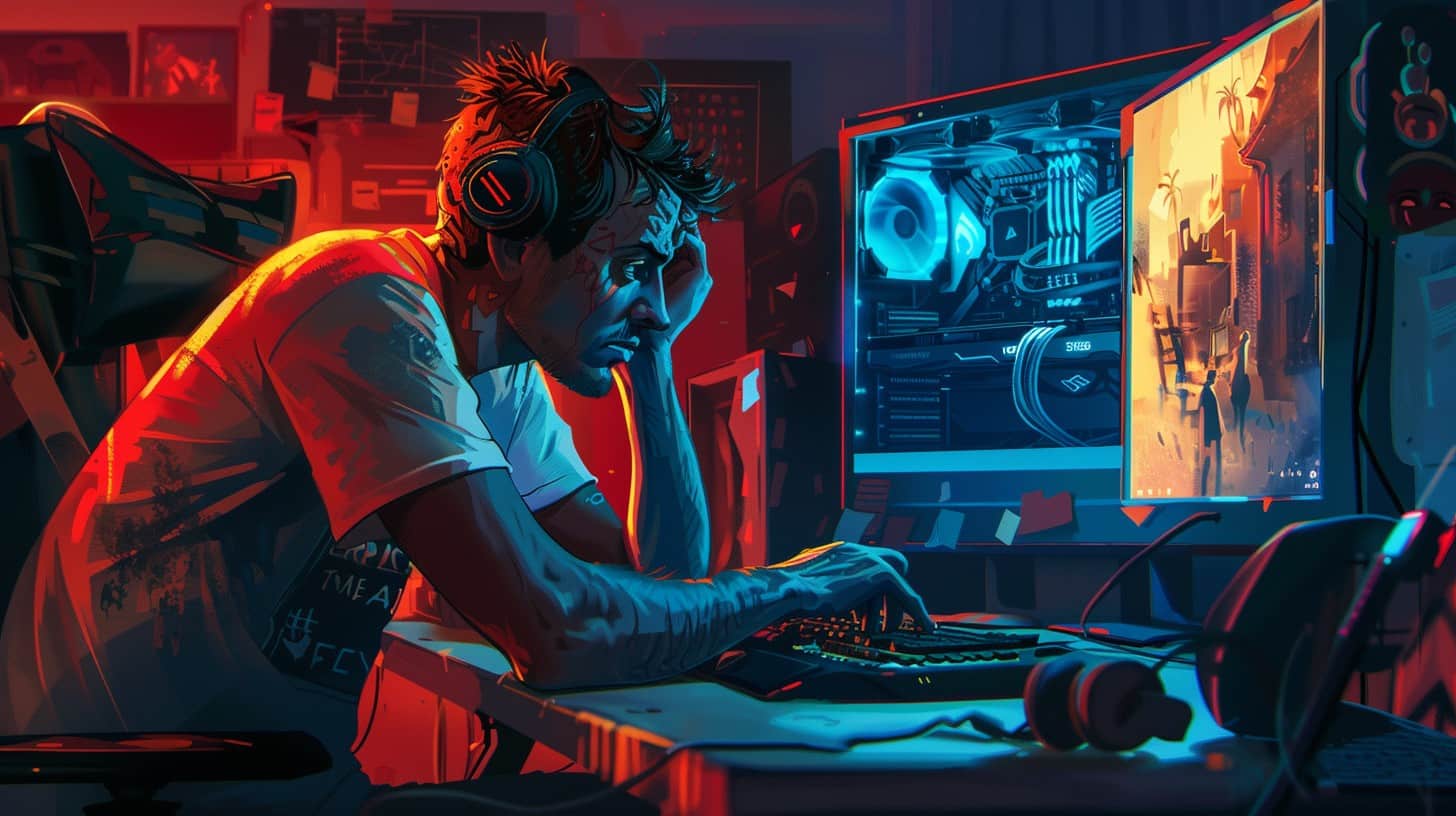Ever felt like your character in a game is moving through molasses? That’s high latency for you. Imagine a world where every move in your favorite online game is as swift as thought.
Our blog walks you through slashing that pesky ping to juice up your playtime. Ready? Let’s roll!
Key Takeaways
Latency in gaming measures how fast actions go from your device to the game server and back. Lower latency means smoother gameplay.
High ping over 40ms slows you down, making games feel like moving through mud. It can ruin online matches and streaming experiences.
Using a wired connection, updating devices, and choosing internet plans designed for gamers can help cut down ping times.
Close extra apps and pick servers close to you for faster response times in games. This makes actions happen almost instantly.
Optimal ping levels vary by game type; fast-paced shooters need less than 40ms for the best experience.
Table of Contents
Exploring Latency in the Gaming World

In the gaming world, latency is like a hidden speed bump on your way to victory. It measures how fast your game actions reach the server and back to you, making it a big deal for players everywhere.
Defining Latency and Its Importance
Latency in gaming is like the time it takes for a letter to travel from your mailbox to a friend’s across the country, but much, much faster. It’s the delay you get between clicking your mouse or pressing a button and seeing something happen on screen.
Think milliseconds, not days or hours. This speed measure is crucial because every millisecond counts in online games. If your latency is high, by the time you see an enemy and react, you might be too late.
Lower latency means smoother gameplay. Imagine playing an intense shooter game; low latency lets you dodge bullets and take down enemies without annoying pauses. On the other hand, high latency turns this fast action into a choppy nightmare where moves happen way after you make them.
That’s why gamers are always hunting for ways to cut down that lag time—because in gaming circles, winning isn’t just about skill; it’s also about how fast your actions hit the game server and come back as movements on your screen.
The Impact of Latency on the Gaming Experience
High ping feels like running in a dream where you can’t quite catch up. Imagine playing your favorite online multiplayer games and you’re about to score. But instead of glory, you face frustration as your character freezes or moves too late.
That’s latency at work, turning potential wins into definite losses. It doesn’t just slow down characters on screen. It makes graphics stutter and disrupts live streams to platforms like Twitch, spoiling the fun for viewers too.
A smooth gaming session is a gamer’s best friend, say experts who know the ropes.
Gamers aim for low ping because it means their actions happen almost at the same time they press buttons. Professional gamers go further, seeking pings under 50 milliseconds to stay ahead of the competition, especially when streaming to Twitch affiliates where every millisecond counts.
According to US Gamblers, this isn’t just limited to traditional video games; online casino game players also thrive on quick responses that only low-latency internet can provide. Moving forward lets dive into comparing high vs low latency in detail.
Comparing High and Low Latency in Games

High latency is like a speed bump in your gaming race, slowing you down at the worst times. Low latency, on the other hand, keeps your game moving smooth and fast, just like riding a bike downhill with the wind in your hair.
Understanding High Latency and Its Consequences
Playing games with high latency feels like running through mud; every move is slow and frustrating. Your commands take ages to reach the game server. Imagine pressing “jump” only to watch your character leap seconds later.
That delay crushes the thrill of gaming, turning epic battles into clumsy dances.
High ping times can wreck an online match quicker than a power outage. With ping over 40ms, gamers start feeling the drag. It’s worse when it shoots past 60ms. Every millisecond counts in fast-paced games where timing is everything.
High latency means you’re always a step behind, making victory seem like a dream out of reach.
The Benefits of Low Latency in Gaming
Low latency makes your gaming smooth and responsive. Imagine your character moving the moment you press a key, shooting with pinpoint accuracy, or dodging attacks in real-time. That’s what low latency offers – a direct line to victory without any hiccups.
It’s like having a superpower where your moves on the controller instantly come to life on screen. This is crucial for games where every millisecond counts, turning near misses into wins.
In the world of online gaming, speed is king.
Using an Ethernet cable instead of Wi-Fi can slash ping times dramatically, making games more enjoyable and competitive. A good internet connection removes frustrating lag that can turn a battle around in seconds.
With speeds ideally below 60ms, players experience gaming as it should be – fast, fun, and fair. Whether you’re live-streaming or going head-to-head in an MMO game, lower pings mean you’re always one step ahead.
Strategies for Minimizing Gaming Latency

Getting rid of high ping feels like unlocking a secret level in your favorite game. With tips like using a cable to connect to the internet instead of Wi-Fi, you’ll see why every millisecond counts.
Practical Tips for Reducing Ping
Latency in gaming can mess up your play big time. You don’t want to be going AFK because your game can’t keep up. Here’s how to slash that pesky ping and boost your gaming sessions:
- Pick a wired connection over Wi-Fi. Cables like Ethernet give you a faster, more stable link to the internet than wireless signals do.
- Shut down any background apps you’re not using. Stuff like streaming services or downloads can hog your bandwidth, making your game lag.
- Move closer to your router if you must use Wi-Fi. The shorter the distance, the stronger and quicker the signal.
- Update your gaming device and router software regularly. Manufacturers often release updates that make devices work better together.
- Choose an internet plan that fits gamers’ needs, like AT&T’s Dedicated Internet plan, offering speeds of up to 1,000 Mbps on a fiber-optic network.
- Connect directly to servers close to you when possible. Less travel time for data means less waiting around in-game.
- Upgrade old modems or routers to newer models designed for heavy – duty internet use—modern tech can handle more data at faster speeds.
- Use Quality of Service (QoS) settings on your router if available; these let you prioritize gaming traffic over other types of internet use.
- Clear cached files and cookies off your devices regularly; this frees up processing power for more important tasks like gaming.
- If all else fails, talk with your internet provider about options for gamers or consider switching to one known for supporting eSports, such as AT&T – they get how vital low ping is for pro-level play.
Sticking with these tips should help keep lag times low and entertainment high during your online adventures. Happy gaming!
Advanced Strategies for Enhancing Gaming Performance
Getting your game to run smoother than ever takes more than just wishful thinking. You’ve got to get the tech right and make smart choices. Here’s how:
- Opt for wired connections over Wi – Fi. A direct cable from your gaming console to the router cuts out a lot of airwave traffic, getting you faster speeds.
- Update your network drivers and gaming rig’s operating system regularly. Outdated software can slow you down without you even knowing it.
- Switch to fiber internet if possible. Fiber optic services blow traditional DSL or cable out of the water with much lower ping times.
- Use Quality of Service (QoS) settings on your router to prioritize gaming traffic. This tells your network to treat game data like VIPs, so they’re not stuck in line behind other data packets.
- Close all background applications before launching your favorite game. Other programs can eat up bandwidth, making your game laggy.
- Choose a server that’s physically closer to you when playing MMO or multiplayer online games. Less distance means data travels back and forth quicker.
- Look into using a content delivery network (CDN). CDNs can lower ping significantly by reducing the physical distance between servers and players.
- Upgrade your hardware if it’s holding you back. Sometimes, the bottleneck is not your internet but an old graphics card or processor.
- For Twitch streamers aiming for professional status, consider a dedicated internet plan specifically designed for low latency and even upload and download speeds.
Each step brings you closer to having the upper hand in every match or quest, giving you that smooth gameplay experience professional gamers talk about—time now to check how fast your connection really is.
Identifying Your Gaming Latency

Finding out your game’s delay is simple. Use tools like the command prompt or online speed tests. Type “ping” followed by your game server‘s web address into the command prompt. This shows how fast you get a response in milliseconds (ms).
Online speed tests can also measure your delay to gaming platforms like Xbox Live, PlayStation, or Steam.
See if network congestion affects your gameplay by checking at different times of day. Early mornings or late nights often have less traffic, giving you lower ping times. Keep tabs on these numbers as they tell you when it’s best to play for a smoother experience.
Optimal Ping Levels for Gaming

Optimal ping levels can make or break your gaming experience. Here’s a simple guide to understand the numbers game.
| Game Type | Ideal Ping (ms) |
|---|---|
| Fast-paced shooters | Less than 40ms |
| Online multiplayer battle games | 40ms to 60ms |
| Strategy and role-playing games | Up to 100ms |
| Turn-based games | 100ms to 150ms |
Aim for 40ms to 60ms for a smooth, lag-free adventure. Lower pings mean you’re ahead of the game. Running a ping test tells you where you stand. Close extra tabs and switch to a wired web connection. This can cut down your latency. Remember, your gaming thrill depends on these numbers. Keep them low, stay ahead.
FAQs About Latency in Gaming
What’s latency, and why does it make my game lag?
Think of latency like the time it takes for a letter to get from you to your friend. In gaming, it’s the delay before your action reaches the game server. If your internet is a slowpoke (high latency), your game lags as if you’re moving through molasses.
How can I tell if my ping is too high?
Ping is like your gaming heartbeat – lower means healthier. If games are stuttering, or you’re always a step behind, check your ping. Aiming for the lowest ping will keep you in the fast lane.
Does my internet type affect my gaming speed?
Absolutely! It’s like choosing between riding a bike or driving a race car to school; DSL might leave you pedaling hard, while cable internet has more vroom-vroom for online play without hiccups.
Why does using Wi-Fi feel like I’m dragging an anchor?
Wi-Fi can be fickle, dropping signals as if it’s juggling them. For lightning-fast responses in real-time games, plug into wired Ethernet—a direct line that doesn’t drop the ball.
Can other devices hogging my internet slow down my gaming?
You bet! When everyone at home streams movies or downloads files, it’s like they’re cutting in line ahead of your game data—leading to packet loss and jittery gameplay on your end.


